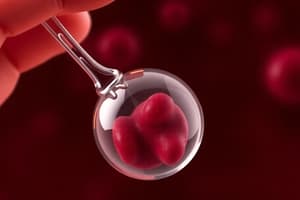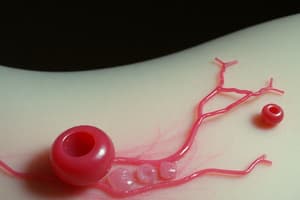Podcast
Questions and Answers
ما هو الدور الذي يقوم به مستقبل الـ ADP (P2Y12) ضمن عملية التجلط؟
ما هو الدور الذي يقوم به مستقبل الـ ADP (P2Y12) ضمن عملية التجلط؟
- زيادة نسبة المستقبل للـ ADP بشكل كبير لإكمال عملية التجمع. (correct)
- المساهمة في تغيير شكل الصفائح الدموية الابتدائي وتعزيز تجمع الصفيحات.
- التسبب في تشكيل جلطة أكثر قوة في الدم.
- تحويل البروثرومبين إلى ثرومبين لتكوين شبكة من الفيبرين.
ما هي الخطوة التالية بعد تحويل الثرومبين للفيبرين في عملية التجلط؟
ما هي الخطوة التالية بعد تحويل الثرومبين للفيبرين في عملية التجلط؟
- تحويل الفيبرين إلى صفائح دموية.
- تتكوين شبكة من الفيبرين تلتقط الصفائح الدموية والخلايا الدموية. (correct)
- تحويل الصفائح الدموية إلى بروثرومبين.
- تحويل الصفائح الدموية إلى ثورومبين.
ما هو السبب الأساسي لاضطرابات التخثر المرتبطة بـ Factor 5 Leiden mutation؟
ما هو السبب الأساسي لاضطرابات التخثر المرتبطة بـ Factor 5 Leiden mutation؟
- زيادة استجابة المستقبل للـ ADP.
- زيادة في إنتاج بروثرومبين. (correct)
- انخفاض نشاط بروتين C.
- سهولة تجلط الدم داخل الأوعية.
ما هو تأثير نقص في بروتين C على عملية التخثر؟
ما هو تأثير نقص في بروتين C على عملية التخثر؟
كيف يؤثر اضطراب التخثر المرتبط بـ antiphospholipid antibody syndrome على تجانس عملية التخثر؟
كيف يؤثر اضطراب التخثر المرتبط بـ antiphospholipid antibody syndrome على تجانس عملية التخثر؟
أيّ من العوامل التالية يُعد سببًا للاضطرابات في عملية التخثر المعروضة بشكل زائد داخل قناة الأوعية؟
أيّ من العوامل التالية يُعد سببًا للاضطرابات في عملية التخثر المعروضة بشكل زائد داخل قناة الأوعية؟
ما الخطوة التي تحدث بعد تفعيل الصفاغ الصفيحي؟
ما الخطوة التي تحدث بعد تفعيل الصفاغ الصفيحي؟
ما هو الجزء المسؤول عن تمديد البوديكودات للصفاغات التي تتجمع معًا؟
ما هو الجزء المسؤول عن تمديد البوديكودات للصفاغات التي تتجمع معًا؟
ما هو دور عامل جي بي 2 ب / 3 أ في عملية تجمع الصفاغات؟
ما هو دور عامل جي بي 2 ب / 3 أ في عملية تجمع الصفاغات؟
ما هو المركب الذي تفرزه خلايا الترومبوسيت عند التصاقها ببروتينات الكولاجين المكشوفة؟
ما هو المركب الذي تفرزه خلايا الترومبوسيت عند التصاقها ببروتينات الكولاجين المكشوفة؟
ما هو التأثير المباشر للانضغاط الوعائي على عملية التخثر؟
ما هو التأثير المباشر للانضغاط الوعائي على عملية التخثر؟
أثناء تكوُّن قطعة من خلايا صفاغية، ما هو نتيجة ربط عامل جي ب / 3 أ؟
أثناء تكوُّن قطعة من خلايا صفاغية، ما هو نتيجة ربط عامل جي ب / 3 أ؟
Flashcards are hidden until you start studying
Study Notes
Hemostasis
Hemostasis refers to the natural process that prevents excessive bleeding from blood vessels when they get damaged. It involves a complex interaction between various components of the blood and the blood vessel walls. The main aspects of hemostasis include vasoconstriction, platelet plug formation, and coagulation.
Vasoconstriction
Vasoconstriction is the initial response to a blood vessel injury, aimed at reducing blood flow. This is accomplished by the contraction of smooth muscles in the vessel walls. Upon injury, endothelial cells stop secreting coagulation and aggregation inhibitors, such as heparin and thrombomodulin, and instead produce von Willebrand factor, which increases platelet adhesion.
Platelet Plug Formation
When a blood vessel is damaged, platelets are the first cells to adhere to exposed collagen proteins in the vessel walls. Platelets contain secretory granules, and when they stick to these proteins, they degranulate, releasing their contents. These substances stimulate further platelet activation and enhance the hemostatic process.
Platelet Aggregation
Platelet aggregation occurs once platelets become activated. This is facilitated by the GpIIb/IIIa receptor on the surface of platelets, which binds to vWF or fibrinogen. Each activated platelet extends pseudopods and becomes clumped together, leading to a primary platelet plug that helps stop blood flow from the damaged site. The ADP receptor (P2Y1) also plays a role in this process, assisting in the initial platelet shape changes and promoting platelet aggregation. P2Y12, another ADP receptor, increases significantly in response to ADP, completing the aggregation process.
Coagulation
Coagulation involves the conversion of prothrombin into thrombin, catalyzed by the PT activator. Thrombin then converts fibrinogen into fibrin strands, forming a mesh that enmeshes plasma, platelets, and blood cells to create a firmer clot. The coagulation cascade consists of two main pathways: the intrinsic (contact activation pathway) and extrinsic (TF pathway).
Hemostatic Disorders
Hemostasis can be disrupted due to various factors, such as hyper-coagulation, where the process is triggered inadvertently within the lumen of the blood vessel without bleeding, or hypo-coagulation, caused by defects in the functionality of any component of the hemostatic cascade. Examples of conditions resulting from hemostatic disorders include antiphospholipid antibody syndrome, Factor 5 Leiden mutation, and protein C deficiency.
Studying That Suits You
Use AI to generate personalized quizzes and flashcards to suit your learning preferences.




